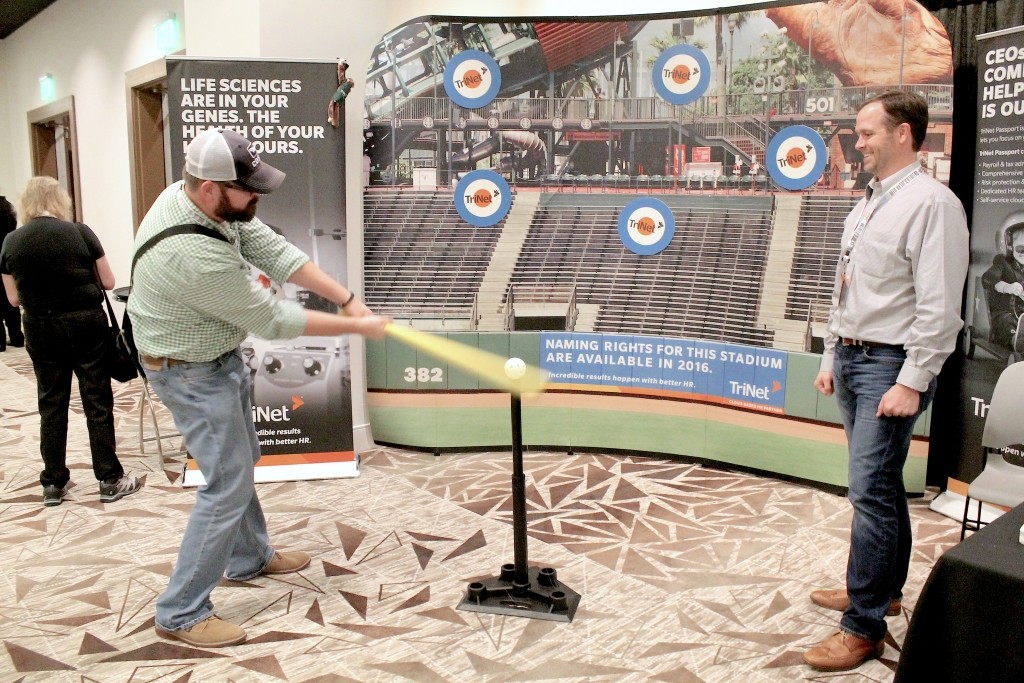SXSW PanelPicker Now Open
Imagine getting to vote for future session content at a conference. Well, South by Southwest (SXSW) allows you to do that with its PanelPicker, which is now open for voting through September 4.
I tell everyone in earshot that SXSW is one of the greatest conferences one can attend for professional and personal development. And now with a convergent track focusing on sports, it’s even more relevant to venue professionals.
There are almost 4,000 entries just in the Interactive track alone, so I focused on the sports theme to help you decide on some sessions to vote for, such as
The Future of Mega-Events
Creating Real-Time Fan Content From Experiences
Game Changer: Inside the World’s Smartest Arena
Are You Engaged? Connecting with Multiplatform Fan
Getting Millennials off the Couch & to the Stadium
The Future of Sports, From the Future Generation
Virtual Reality as a Fan Engagement Tool
How Basketball is Making the Golden State Greener
The Future of the eSports Revolution
What Will a Sports Fan Look Like in 2030?
Coming 2 U Live: the Future of Streaming & Sports
How to Reach Consumers via Less Traditional Sports
Keeping Your Eye on the Ball: Engaging Today’s Fan
Fair warning, not all of these sessions will make the cut, but by voting for them, you definitely help their chances of being in the program. Check out the PanelPicker site to view more proposed sessions, and let me know if you plan to attend SXSW next year (March 11-20) in Austin, Texas.
Further reading: Our blog posts from 2015 SXsports: “The New Cathedral: Sports Stadiums” and “The In-Stadium Fan Experience in MLS.”
(Image: SXSW/Robert Ward)
There’s Big Money to be Made in eSports
KeyArena in Seattle played host to 12,000 professional video game players last week for the International Dota 2 tournament—an event that offers a $6.5 million prize for the first place winner. To compare, Jordan Spieth netted $1.8 million for winning the 2015 Masters Tournament.
So, what do you need to know about this increasingly popular sport? Well, the good folks at Engadget provided the following interactive infographic to help you understand it better.
Kansas State University Opens Vanier Family Football Complex
The Vanier Family Football Complex is now open at Kansas State University.
“It is a great day for K-State as the beautiful new Vanier Family Football Complex is operational and open for our football staff and student-athletes,” said Athletics Director John Currie in a statement. “This new facility is another example of our commitment to a world-class, student-athlete experience and being a model intercollegiate athletics program while furthering our position as a leader at the highest level of intercollegiate athletics. We appreciate the flexibility of our staff during this process and also the hard work and hustle of our design and construction management teams as well as all of our donors who helped make this project a reality. It was truly a team effort, and I know this is a facility that the K-State Nation will be proud of and will be the envy of all other programs.”
The 132,000-square-foot building was completed in just seven months by the construction management team of Mortenson & GE Johnson Construction and in conjunction with sports design firm Populous ahead of schedule and under budget.
“Our ability to finish early and under budget was predicated on a ‘project first’ mentality,” said Adam Hardy, senior project manager for Mortenson/GE Johnson Construction, in a statement. “Nearly 1,700 craft workers worked through freezing temperatures, torrential downpours, and 60-hour work weeks to make sure the K-State Family would return to a new-and-improved stadium.”
The complex includes a new student-athlete enhancement center, an 18,000-square-foot Olympic-quality strength and conditioning center, and a new sports medicine and recovery facility. There are also individual position meeting rooms and offices for the staff, as well as a locker room that is twice the size of the previous room.
“The Vanier Family Football Complex represents K-State’s commitment to excellence in athletics, academics and the student-athlete experience,” said Ben Stindt, principal at Populous. “The design combines an efficient design with state-of-the-art technology and high-end amenities that will make the complex feel like home for student-athletes, staff, and fans. This is the next generation of the training experience and fan experience in collegiate athletics.”
Members of the football team were provided their first access to the facility on last week, which you can watch below.
Members of the Vanier family, the namesake of the new complex and lead contributors to the facility, were also there for the first look.
“The facility is absolutely incredible and something that the student-athletes and fans deserve,” John Vanier said. “I had the opportunity to travel around the country touring other facilities when this process began, and I did not see any other that even compares to this one. It is absolutely the perfect facility and one that every school in the nation would aspire to have.”
(Image: Populous)
30|UNDER|30 Spotlights: Barrow, Enkhbayar, Keen, and Rowley
This week’s finale spotlight of recipients in the IAVM Foundation’s inaugural class of 30|UNDER|30 are asked, “What influenced you to get involved in the venue industry?”
 Natalie Barrow
Natalie Barrow
Director of Arts Education and Community Outreach
Cobb Energy Performing Arts Centre
Atlanta, Georgia
“There are two main reasons I got involved in the venue industry, which are my passion for arts and entertainment and serving the public.”
Bill Enkhbayar
Event Manager
Global Spectrum – Boardwalk Hall
Atlantic City, New Jersey
“I was a grad student at Temple University, and I was working for an arena there. While I was working, I got bitten by the bug and I never looked back. It’s something that I’m very passionate about.”
 Ashley Keen
Ashley Keen
Technical Director – Ikeda Theater
Mesa Arts Center
Mesa, Arizona
“I got involved in the industry when I was given the amazing opportunity to be part of the team that put together the CNN Republican national debate.”
McKenzie Rowley
Premium Seating and Suite Sales Manager
SMG – NRG Park
Houston, Texas
“The thing that influenced me the most was definitely my undergraduate degree. Students were encouraged to get experiences through internships and co-op opportunities.”
Using Tethered Drones for Safety and Security
The latest trend in the drone world involves cables to help them with battery life and to keep them from flying away.
“So-called tethered drones use ultrastrong-but-lightweight cables connected to the ground to provide power, a data link and a physical restraint,” Jack Nicas and Tarun Shukla reported for the Wall Street Journal. “That gives them distinct advantages over their free-flying cousins, including hourslong flight times, fast data transmission and an assurance that they won’t fly into an airliner.”
Nicas and Shukla wrote that these tethered drones can be used as surveillance devices and as ways to consistently collect data. Some professional football teams are looking into using the devices.
Please read the Wall Street Journal article, “Some Drones Are Put on a Leash” to learn more about tethered drones.
Do you want to receive a Front Row News weekly digest?
Categories
- Allied (861)
- Architecture (147)
- Arenas (747)
- Career (897)
- Convention Centers (895)
- Education (623)
- Events (1,544)
- Food & Beverage (193)
- Foundation (113)
- Guest Experience (1,496)
- Industry News (2,270)
- Leadership (1,888)
- Marketing (150)
- Membership (2,000)
- Music (213)
- Performing Arts Centers (454)
- Professional Development (409)
- Research (127)
- Safety & Security (442)
- Sports (763)
- Stadiums (608)
- Student (159)
- Technology (516)
- Ticketing (92)
- Touring (82)
- Trends (364)
- Uncategorized (725)
- Universities (218)
- Video (25)
- Young Professional (198)
Twitter Feed
- Twitter feed loading
Recent Posts
- McNamara Named General Manager of Will Rogers Memorial Center
- Matt Rife Breaks Record for Most Tickets Sold for a Comedy Show at Honda Center
- The Events Industry Council Recognizes the Miami Beach Convention Center (MBCC) for Achieving Gold Level Sustainability Certification
- Raleigh Convention Center Shares Designs of Upcoming Expansion
- Acrisure Arena Wraps ‘Magnificent 7’ with Record-Setting Week of Live Entertainment, Welcoming Fans from All 50 States
Categories
- Allied
- Architecture
- Arenas
- Career
- Convention Centers
- Education
- Events
- Food & Beverage
- Foundation
- Guest Experience
- Industry News
- Leadership
- Marketing
- Membership
- Music
- Performing Arts Centers
- Professional Development
- Research
- Safety & Security
- Sports
- Stadiums
- Student
- Technology
- Ticketing
- Touring
- Trends
- Uncategorized
- Universities
- Video
- Young Professional
Archives
- November 2025
- October 2025
- September 2025
- August 2025
- July 2025
- June 2025
- May 2025
- April 2025
- March 2025
- February 2025
- January 2025
- December 2024
- November 2024
- October 2024
- September 2024
- August 2024
- July 2024
- June 2024
- May 2024
- April 2024
- March 2024
- February 2024
- January 2024
- December 2023
- November 2023
- October 2023
- September 2023
- August 2023
- July 2023
- June 2023
- May 2023
- April 2023
- March 2023
- February 2023
- January 2023
- December 2022
- November 2022
- October 2022
- September 2022
- August 2022
- July 2022
- June 2022
- May 2022
- April 2022
- March 2022
- February 2022
- January 2022
- December 2021
- November 2021
- October 2021
- September 2021
- August 2021
- July 2021
- June 2021
- May 2021
- April 2021
- March 2021
- February 2021
- January 2021
- December 2020
- November 2020
- October 2020
- September 2020
- August 2020
- July 2020
- June 2020
- May 2020
- April 2020
- March 2020
- February 2020
- January 2020
- December 2019
- November 2019
- October 2019
- September 2019
- August 2019
- July 2019
- June 2019
- May 2019
- April 2019
- March 2019
- February 2019
- January 2019
- December 2018
- November 2018
- October 2018
- September 2018
- August 2018
- July 2018
- June 2018
- May 2018
- April 2018
- March 2018
- February 2018
- January 2018
- December 2017
- November 2017
- October 2017
- September 2017
- August 2017
- July 2017
- June 2017
- May 2017
- April 2017
- March 2017
- February 2017
- January 2017
- December 2016
- November 2016
- October 2016
- September 2016
- August 2016
- July 2016
- June 2016
- May 2016
- April 2016
- March 2016
- February 2016
- January 2016
- December 2015
- November 2015
- October 2015
- September 2015
- August 2015
- July 2015
- June 2015
- May 2015
- April 2015
- March 2015
- February 2015
- January 2015
- December 2014
- November 2014
- October 2014
- September 2014
- August 2014
- July 2014
- June 2014
- May 2014
- April 2014
- March 2014
- February 2014
- January 2014
- December 2013
- November 2013
- October 2013
- September 2013
- August 2013
- July 2013
- June 2013
- May 2013
- April 2013
- March 2013
- February 2013
- January 2013
- May 2012
- March 2012
- December 2011
- November 2011
- October 2011
Recent Comments
- Frank Bradshaw, Ph.D., CVE on John Meyer, CVE, a Tireless Advocate of Certification for Venue Professionals, Has Died
- Neil Sulkes on Hilary Hartung, Friend to Many in Venue Marketing, Has Left Us
- Jason Parker, CVE on The Devastation of Hurricane Helene and How We Can Support One Another
- Larry Perkins on Touhey Testifies Against Speculative Ticketing Before Congressional Subcommittee
- Peter Secord on Major Players for Planned Elkhart Amphitheater Were in the Mix at VenueConnect






